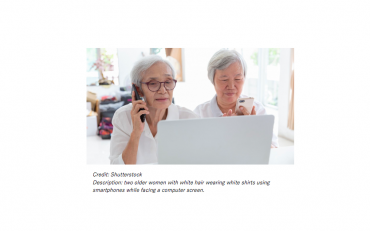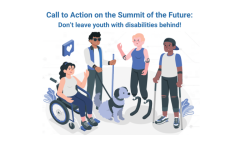By Bethany Brown, Human Rights Advisor, The International Disability Alliance, and
Nena Georgantzi, Policy Coordinator, Human Rights & Non-Discrimination, AGE Platform Europe
The theme of this year's United Nations International Day of Older Persons, which takes place on October 1, is digital equity. Covid-19 has likely accelerated the uptake of digital technology for those who could access it, while leaving those without access further behind. Among those left behind, and often forgotten, are older persons with disabilities.
The disability rights movement has a strong point of intersection on digital equity for older persons: accessibility. For many older persons, long-term disabilities interact with barriers to their access to the digital world including poorly designed websites, little access to services and supports, and ageism.
A focus on barriers is a critical component of the paradigm shift of the Convention on the Rights of Persons with Disabilities (CRPD). It changed the focus of disability from being about a “problem to be fixed” to being about the interaction between people and society. The social definition of persons with disabilities includes those who have long-term physical, mental, intellectual or sensory impairments which, in interaction with various barriers may hinder their full and effective participation in society on an equal basis with others.
Put another way, a social definition of persons with disabilities makes it clear that an older person with a disability is not the problem, but barriers to their equal participation in society - including equitable digital participation - are the problem.
In Article 9 of the CRPD on accessibility, States party to the Convention commit to the identification and elimination of obstacles and barriers to accessibility, including in electronic information services. The principle of accessibility applies to the design of mobile phones, websites, applications, and ATMs, among other digital products and services.
The right to accessibility is connected to many other rights, including the rights to employment, political participation, health, and information. Inaccessible digital technology is increasingly a barrier to the realization of these rights as the world moves online. For example, an older person who became partially sighted in older age may encounter an inaccessible website to sign a petition to their local government, impacting their right to political participation on an equal basis with others.
Another barrier hindering digital equity for older persons with disabilities is explicit ageism in policies. Older persons with disabilities may not have access to individual supports for accessibility such as personal assistance, screen-reading technology, or hearing aids on an equal basis with younger persons with disabilities.
Ageism in society can also be internalized, leaving older persons, with and without disabilities, to contend with the barrier of internalization of negative stereotypes. Studies on self-ageism reflect this. One such study was reported to find “if older individuals themselves have internalized the belief that older people cannot learn anymore or are less capable of using digital technology, they may be at risk of actually having greater problems in adopting new digital technology.”
Acceleration of digitalization during the pandemic has shown that we must challenge the exclusion of older persons with disabilities: inaction will result in those of us who are older with disabilities being left behind. This is a great loss both for individuals and the societies that miss out on our participation.
Older persons are already calling for design for all. Governments should develop inclusive policies and regulations for accessibility, in full consultation with older persons with disabilities and their representative organizations.
We have the right to have a say in how such policies are designed and rolled out. This promotes our right to participation and promotes all the rights that flow from the use and adoption of digital technology. It’s a newly-digital world, and we all have a right to participate in it.
The International Disability Alliance is a network of eight global and six regional organisations of persons with disabilities and their families, representing the estimated one billion persons with disabilities worldwide.
AGE Platform Europe is a network of organisations of and for older persons that lends voice to and promotes the interests of older persons in the European Union.

